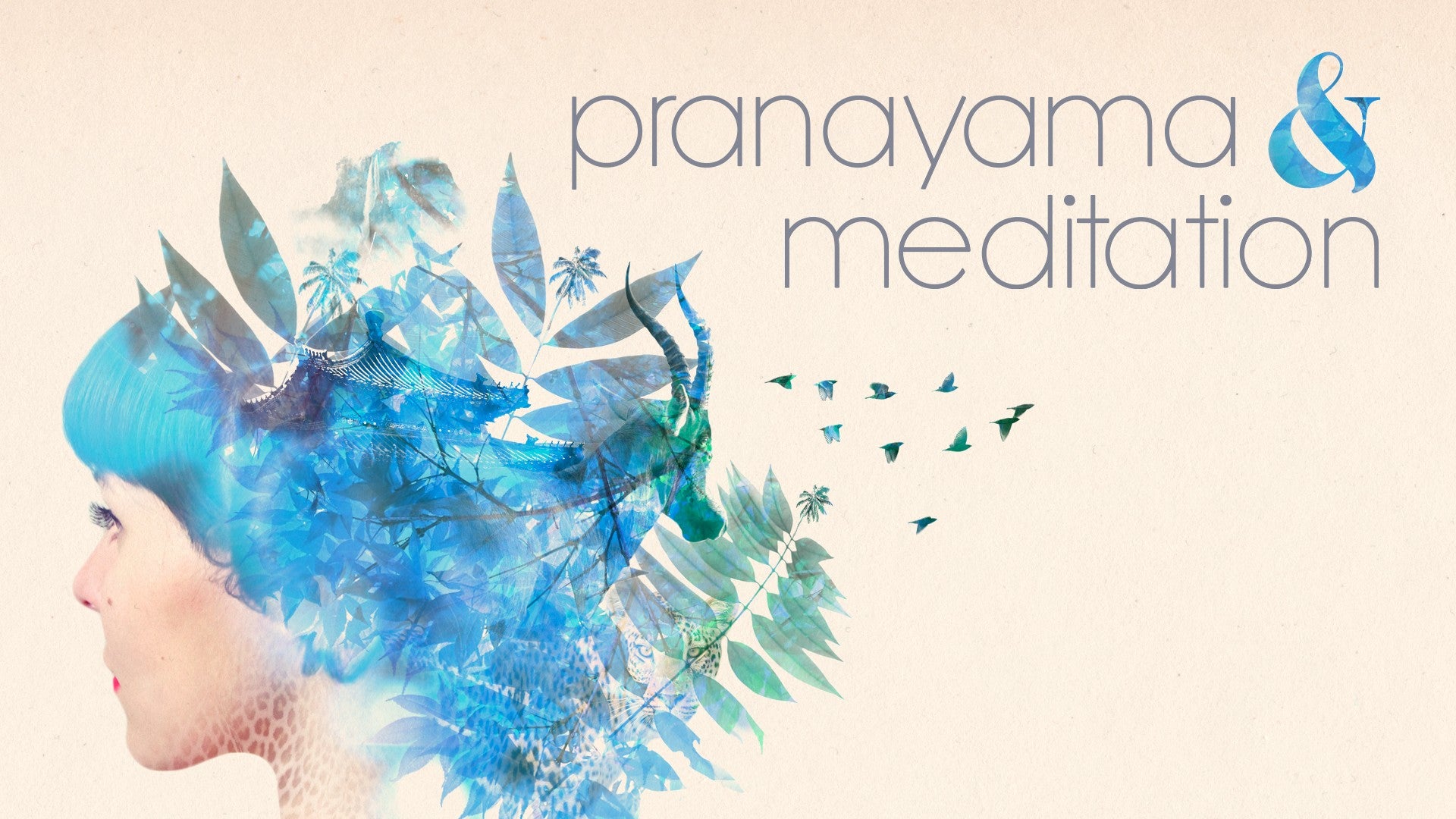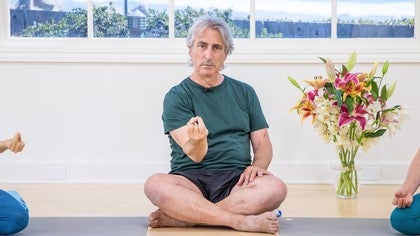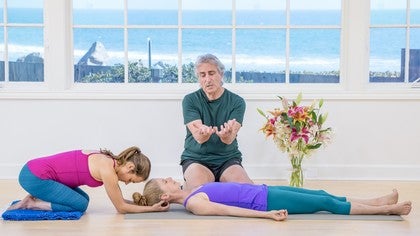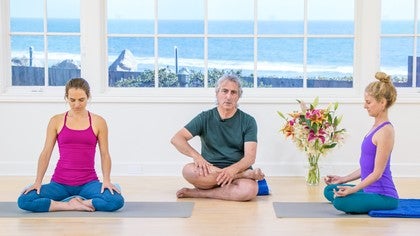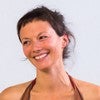Description
About This Video
Transcript
Read Full Transcript
Hi, we're here with Betsy and Alana and we are doing a partner exercise in preparation for what's called Jalandharabhanda, usually called Jalandharabhanda. It's usually interpreted in English as the throat bond or the throat lock, neither of which terms I like very much. We'll get into that a little bit more when we get to the actual practice. Right now we're doing a preparation for that exercise, which is a central exercise in the practice of pranayama. The reason why we're doing this exercise is because normally what you hear in the yoga class as an instruction to perform this position is that you bring your chin down to your sternum, and I don't particularly care for that instruction.
I would rather see the sternum come up toward the chin, which keeps the back of the neck softer. We are going to do an exercise that will help us learn how to boost the sternum bone to bring it up to the chin as the chin descends. Betsy, as you can see, is lying down on her back and Alana is going to be the helper. The first thing Alana is going to do is make her hands into sort of like a claw. The hands will be curled like this so the fingertips are active, and then she'll bring her hands underneath the back of Betsy's head.
The tips of the fingers will press against the space between the back of the head and the back of the neck. There's a little soft area in there. The back of the head then will rest in the cupped palms. With somebody like Betsy, Alana is going to not feel much resistance at the base of the skull. Typically, though, with many practitioners, what you'll feel initially is a little bit of thickness at the base of the skull.
You have to be very careful that you don't invade that space immediately with your fingertips. You curl the fingers and you very gently sort of palpate the fingers up and down against that space between the back of the head and the back of the neck and wait for the person that you're working with to agree to soften that space and let his head sink down onto your hands. But as I say, with more advanced or more experienced practitioners, you won't feel much resistance at the base of the skull. When you begin to feel that softening, then you can start to apply a little bit steadier pressure against the space between the back of the head, back of the neck and also begin to pull gently at first and then adding a little bit more as you go along the back of the head away from the back of the neck. What you're trying to create is a feeling of opening a space between the occiput, which is the bone at the back of the head and the back of the neck.
The back of the neck descends along the back of the torso now through the tailbone toward the heels. The back of the head lifts away from that action and slides up toward the crown. Again, I've mentioned this a couple of times before, this is not a physical movement. In other words, you don't simply just push your chin down towards your sternum to create space in that area. You have to create a kind of imaginary or imaginative or energetic or a release at the base of the skull.
What you'll feel when you have it, you'll know you have it when you feel a release of the crook of the throat right here where the underside of the chin meets the front of the neck. Of course, you may know that underneath the crook of the neck is a small bone called the hyoid bone, which is a very unusual little bone. It's the only bone in the body that isn't attached directly to another bone. It's the root of our favorite muscle, the tongue. What you'll feel then as the base of the skull releases is that the hyoid bone is pulled up diagonally into the head toward the top of the spine.
The other thing that happens then is that the tongue can soften down on the floor of the mouth and the soft palate will sort of dome up away from that toward the cranial vault and you'll feel the oral cavity getting much bigger. This is a way that you begin to initiate the movement into Jalandharabhanda. You need to create that release at the base of the skull, which begins the drawing of the crook of the throat here and here into the head, which in turn will start a little bit of a magnetic pull on the top of the sternum bone here. The first thing that happens in Jalandharabhanda is at the top of the sternum bone. The manubrium is drawn up.
Now it looks like Betsy's getting there and what I'm going to ask Alana to do is to gently release her head onto the floor. What Alana will do is slide her hands out slowly from underneath the back of her head and let the head then rest down gently on the floor. And there's one more thing that we want to work with here, very good. So we'll ask Betsy to take a few breaths, come back to the consensus reality and then roll over to the side with an exhalation. Push yourself away from the floor, exhale using the strength of the arms, dragging the head as always.
And then we'll have Betsy come and sit in front of Alana with her back to Alana. Would you please sit in Vajrasana rather than cross leg? Now Alana, the first thing she's going to do is she's going to reinforce that lift of the base of the skull. So she'll take a hand, either one, and grab onto the back of the head and just give a very gentle lift to the base of the skull. Very nice.
Betsy then will feel the shoulder sort of hanging from the back of the neck and she'll feel once again the slight lift of the crook of the throat. The second step is to take those fingertips and begin to slide them down the back of the neck and the back of the torso until you reach the lower tips of the shoulder blade. So you watch as Alana takes the hand down, find the lower tips of the shoulder blades. And now she's going to do a push and it's going to be into the torso toward the front and then up in the diagonal direction to here at the top of the sternum bone. So the first thing that we do in preparation for Jalandharabhanda is to lift the top of the sternum bone, the manubrium.
And in order to do that, there's two things that need to happen. The base of the skull needs to release away from the back of the neck, which draws the crook of the throat deeper into the head, which pulls on the manubrium here. And the lower tips of the shoulder blades angle up diagonally into the torso and boost the already lifted manubrium up. Now she's ready to bring the chin into Jalandharabhanda. Now I don't exactly want her to bring the chin down.
What I wanted to do is take the crook of the throat and draw it up into the head and let the chin sort of swivel over that release. It's like she's doing a forward bend with her head and the crook of the throat represents the groins. So she'll pull this up and then start to take the head down a little bit, keeping the lift to the top of the sternum bone as she does. Now remember not to force the chin down onto the sternum. If it doesn't come comfortably, just let the chin hang.
Very nice. The bandha is often translated into English as bond or lock, not a very useful idea. I like to think of the bandha more as a valve and you're very gently and carefully adjusting that valve. And of course what you're doing here in this exercise is two things, and we'll get into that as we work directly with Jalandharabhanda. Very nicely done, as you can see, the back of the neck stays relatively soft and the movement of the head forward is coming from the root of the neck which is deep in the upper back at the base of the shoulder blades.
It's very nicely done. Take the head up with an inhalation and if Alana would slide her hand down the back of the torso now through the tail toward the floor, that would be good. Nicely done. And that is a preparation for Jalandharabhanda. Thank you.
Pranayama & Meditation: Meet Your Breath
Comments
You need to be a subscriber to post a comment.
Please Log In or Create an Account to start your free trial.
